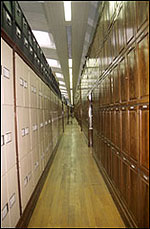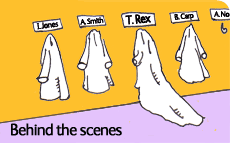What's in a name? A history of taxonomy
By Sandra Knapp
The future of taxonomy
These are exciting times for taxonomy. New techniques are being developed all the time, and these often throw up as many questions as provide answers.
The changing world
Thinking point
How important is the science of taxonomy? Would the conservation of biodiversity be possible without the information provided by taxonomists?
Taxonomy's challenges for tomorrow relate to the two threads that construct its fabric--to name and identify species and to determine the relationships between them--with the aim of ultimately understanding how nature's wild, wonderful diversity is generated. During the science's history, while new ways of looking at characters and methods of depicting relationships have been developed, many new species have continued to be discovered. Linneaus knew of 23 species of Solanum, the plant genus to which the potato and tomato belong, in 1753. By 1852 the next Solanum monograph, compiled by a French botanist working in Montpellier, Michel-Felix Dunal, described 900 species. Now there are thought to be more than 2000 species of Solanum. And this is just one example from one genus in one part of the world, the New World tropics.

Trees being cleared in the Peruvian Amazon.
While ideas about relationships are changing, and new species being described, the world around us is constantly changing. It sometimes changes for the better, but more often for the worse. Deforestation and habitat destruction are immense problems on a global scale. For example, Eastern Paraguay is about twice the size of Great Britain and was once largely covered with semitropical rainforest. In 1945, about 50 percent of eastern Paraguay was covered by forest. By 1991 that forested area had shrunk to just 15 percent. Today patches of green are few and far between. Paraguayan biologists and conservation workers have a very hard task ahead to save those few remaining patches--but they are trying and succeeding.

The herbarium at The Natural History Museum.
In 1992, world leaders attended the Earth Summit in Rio de Janeiro to discuss the problem. The result of that meeting and years of hard work by those interested in the conservation of biodiversity was the United Nations Convention on Biological Diversity, to which about 170 countries, including Great Britain, are signatories. Under the convention (called the CBD) countries are obliged to monitor biodiversity and to promote sustainable development. At first glance, this does not appear to have a huge amount to do with taxonomy, but one of the articles of the Convention requires every signatory country to identify and monitor the biodiversity of the organisms within its borders. How can biodiversity be identified and monitored?
Biodiversity and the role of taxonomy
As the world becomes increasingly urban and globalised, people become disconnected from the natural world around them. To conserve diversity we need to also be able to develop some sort of feeling for it. In Great Britain or the United States it would be relatively easy to grab a field guide and to identify the animals and plants we see around us. But tropical ecosystems are much more complicated; such great numbers of species live in the rainforest that it's very hard to identify and catalogue them. But knowing about organisms is part of what makes people care about them. And biodiversity isn't just about the big, easily recognised species, it's also about countless small species that might, individually, seem totally insignificant. Biodiversity is about the totality of things--just like in the first days of taxonomy.
Biodiversity and the UN convention
Biodiversity is the term given to the variety of life on Earth and the natural patterns it forms. Present biodiversity is the fruit of billions of years of evolution, shaped by natural processes and, increasingly, by the influence of humans. It forms the web of life of which we are an integral part and upon which we so fully depend. This diversity is often understood in terms of the wide variety of speices on Earth. So far, about 1.75 million species have been identified, mostly small creatures such as insects. Scientists reckon that there are actually about 13 million species, though estimates range from 3 to 100 million. Biodiversity also includes genetic differences within each species, for example, between varieties of crops and breeds of livestock. Chromosomes, genes, and DNA--the building blocks of life--determine the uniqueness of each individual and each species.
Yet another aspect of biodiversity is the variety of ecosystems such as those that occur in deserts, forests, wetlands, mountains, lakes, and agricultural landscapes. In each ecosystem, living creatures, including humans, form a community, interacting with one another and with the air, water and soil around them. It is the combination of life forms and their interactions with each other and with their environment that has made Earth a uniquely habitable place for humans.
Taxonomy's role is vital, because without taxonomists documenting the natural world, we no longer have the fabric that underpins not only biology, but also the science of conservation. Taxonomy is a science that keeps pace with the present but also draws upon the wealth of knowledge accumulated throughout its history. At the same time it is constantly making advances, and looking at organisms and their characters in new and ever more creative ways. Who knows what the next generation of characters will be?
Taxonomy in the twenty first century will seem completely different than that of the past--but like good fabric, it still retains both of its threads. Taxonomists do not discard their past, but build upon it in ever more creative ways. While retaining our past, we look forward to increased relevance, both to society at large through our participation in global efforts to conserve the world in which we live, and scientifically, as we refine ever further our hypotheses about life itself. But being a taxonomist today is more difficult than it has ever been--you need to be able to drive both a jeep and an automatic sequencer--but sadly, we are a shrinking community, perhaps as endangered as the organisms we study.
But the future is not bleak--linkages between science and society mean that the role of taxonomy is becoming more appreciated now than ever before. We still have a lot to do, even more so now than when Alfred Russel Wallace penned these somewhat prophetic words:
… the most perfect collections possible in every branch of natural history should be made and deposited in national museums, where they may be available for study and interpretation.
If this is not done, future ages will certainly look back upon us as a people so immersed in the pursuit of wealth as to be blind to higher considerations. They will charge us with culpably allowing the destruction of [that] which we had it in our power to preserve; and while professing to regard every living thing as the direct handiwork and best evidence of a Creator, yet, with a strange inconsistency, seeing many of them perish irrecoverably from the face of the earth, uncared for and unknown.
Toolbox

Our fossil insect collection includes Rhyniognatha hirsti, the world's oldest fossil insect, dating back some 400 million years.

